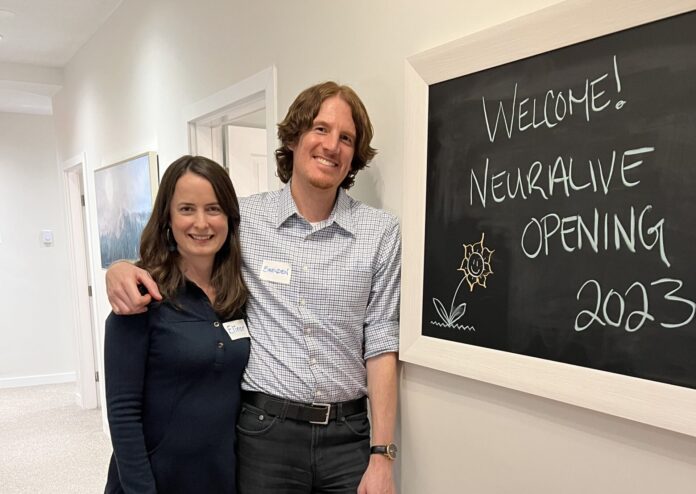In a world of climate doom, financial doom and a never-ending list of other kinds of doom one can endure, there is a clinic that operates out of both Langford and Fernwood that offers free and easy services to Indigenous folks looking to improve their mental health.
Partners in life as well as business, Elinor and Brenden Taylor, met each other through their shared professional background in mental health wellness and eventually opened up a clinic together that offered both counselling and also specialized in Neurofeedback.
NeurAlive is the clinic they initially opened in Oak Bay back in 2018, before closing through the pandemic and reopening in Fernwood. In addition to this location and homebase, the duo recently opened a second location to help better serve clients on the Westshore.
NeurAlive sets themselves apart because of their specialization in Neurofeedback and because they work closely with First Nations organizations in order to get Indigenous clients access to free services in an easy way that puts none of the burden on the clients themselves.
Free services for Indigenous folks
“We’ve had a relationship with the Victoria Native Friendship Centre since 2018 and we had initially been bringing our service into their centre,” Elinor told Victoria Buzz.
“All of our services are actually covered by the First Nations Health Authority.”
This allows for the business to operate as normal and get paid a slightly reduced fee from the First Nations Health Authority’s (FNHA) funding.
NeurAlive takes care of all the red tape and barriers too, so Indigenous clients don’t have to do anything but book their appointment and ask them about FNHA funding while doing so. NeurAlive will take care of the rest.
“When people hear about FNHA, they think, ‘there will be all kind of bureaucracy, I’ll have to sign this and do this, jump through so many hoops,’” Brenden added.
“For Indigenous people who want to experience Neurofeedback, it’s quite a simple process.”
“It takes three to five minutes on a phone call with our assistant who will take down the necessary information and we contact FNHA. It takes a couple weeks to get approval but then we call them back and say, ‘let’s set up your first session.”
“If people are dealing with trauma and possibly intergenerational trauma, making that process as streamlined as possible, I think, is very important and can lead to building great trust,” Brenden explained.
This streamlined process allows Indigenous folks access to certain counsellors that operate out of NeurAlive as well as allowing them to access Neurofeedback with ease.
Benefits of Neurofeedback
Neurofeedback is a type of mental wellness therapy that has been in the works since the 1960s and is gaining traction for people who want to improve the way their brain thinks.
“Even though it seems new to a lot of people, it’s been around for quite a while and there’s a lot of research supporting it from major institutions,” explained Elinor. “Only recently has it become more accessible to the public.”
All Neurofeeback involves a device, software and a patient.
A device is hooked up to a patient via small nodes that are adhered to the scalp using a paste that easily comes off afterward and the nodes do not send any signals or electricity into the brain — it detects your brain’s activity.
The device then sends those signals to a software program that will create some indication for the patient when a ‘pathway’ for the brain’s signals could be improved upon.
This sounds complicated but in essence, the patient will be positively reinforced to have their thoughts and their brain’s signals take better paths which lead to better real-world outcomes and they get to listen to music throughout the treatment.
“When the software detects certain kinds of inconsistencies, anywhere in the frequencies across the surface of the brain, the music that the client is listening to will just briefly pause for a moment and sound like little pops or static,” said Elinor.
“These little pauses in the music are happening simultaneously with that activity — those inconsistencies — and essentially, interrupting brainwaves at these precise moments that trigger the self-correcting mechanism of the nervous system.”
That system naturally guides the brain to choose more efficient pathways through the brain, according to Elinor.
This type of Neurofeedback treatment has been proven to help people who deal with anxiety, depression, indecision, post-traumatic stress disorder.
Elinor says that she decided to hone in on Neurofeedback because she first tried it on herself and her family who all saw immediate, profound results that improved their lives. Following this, she took on clients and saw results she described as “extraordinary.”
“It was helping kids through profound anxiety, or post-traumatic stress disorder, or learning disabilities, various challenges that I was seeing various benefits in — whether they were subtle or life-changing,” Elinor told Victoria Buzz.
“It occurred to me that this is good for all brains so I just wanted to share it more broadly and to this day it remains the best tool I know of or use in my therapy practice.”
“It can unstick old, deep, entrenched patterns in the brain, really freeing people to become more alive.”
NeurAlive operates two clinics out of Fernwood and in Langford, which are both open from Monday to Friday, 10 a.m. to 6 p.m.



